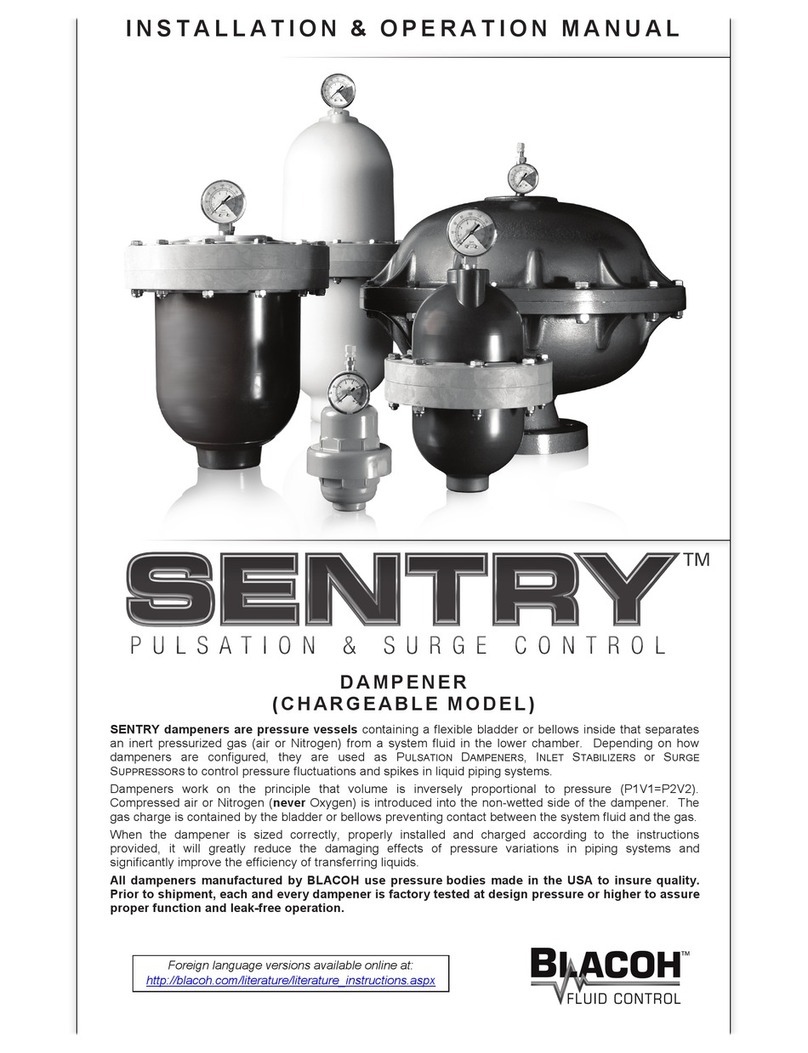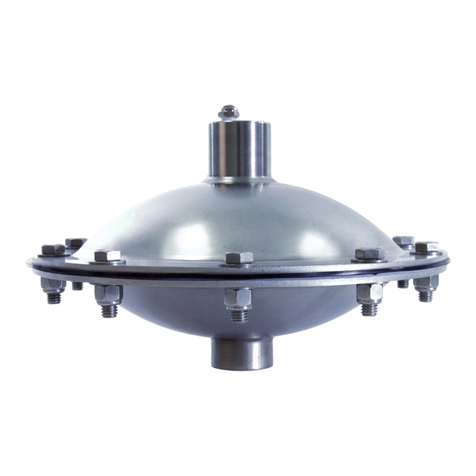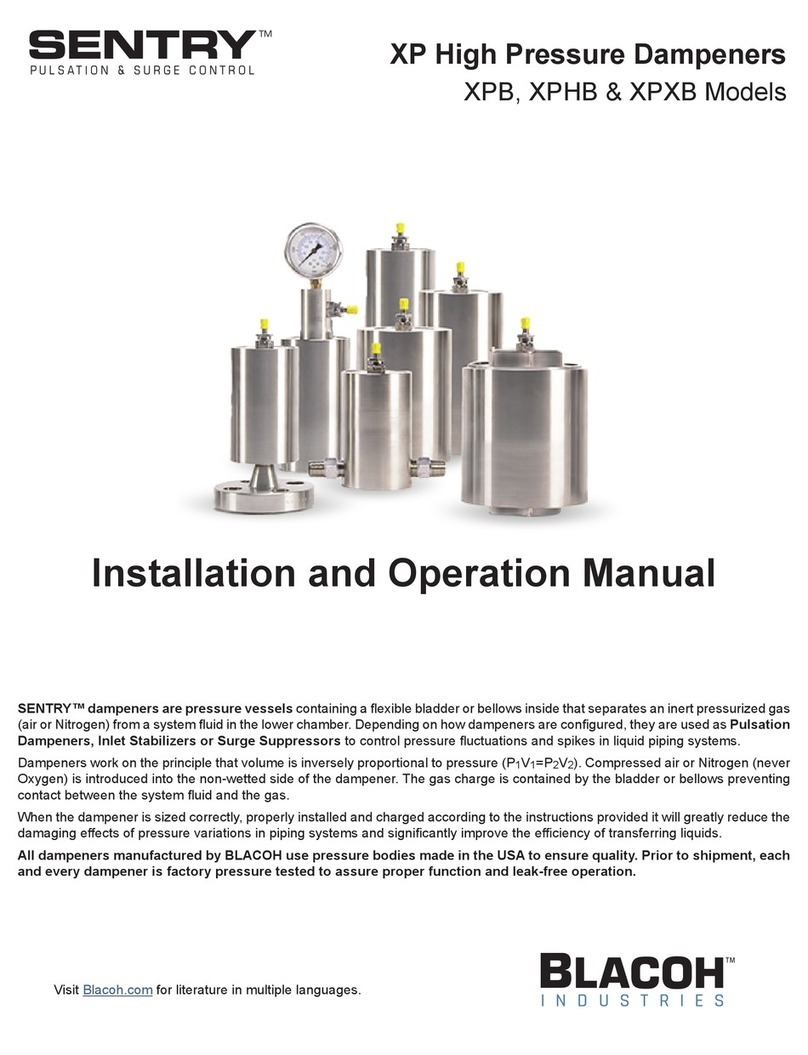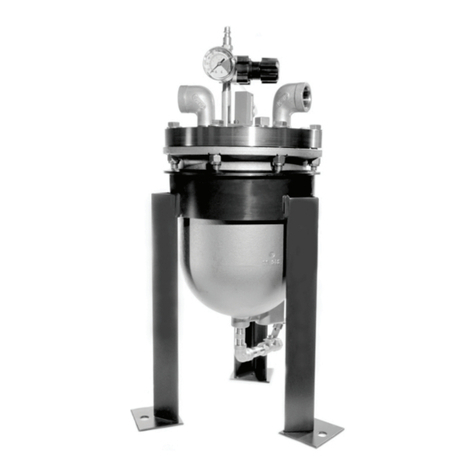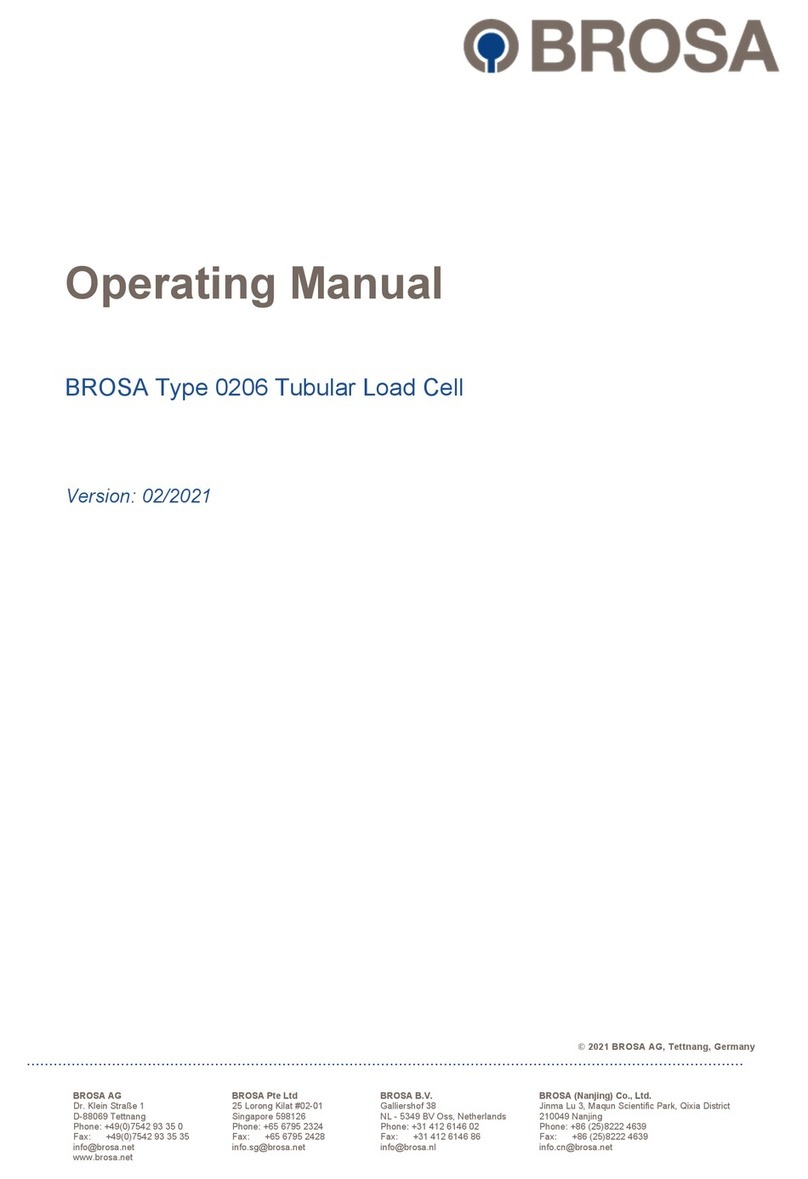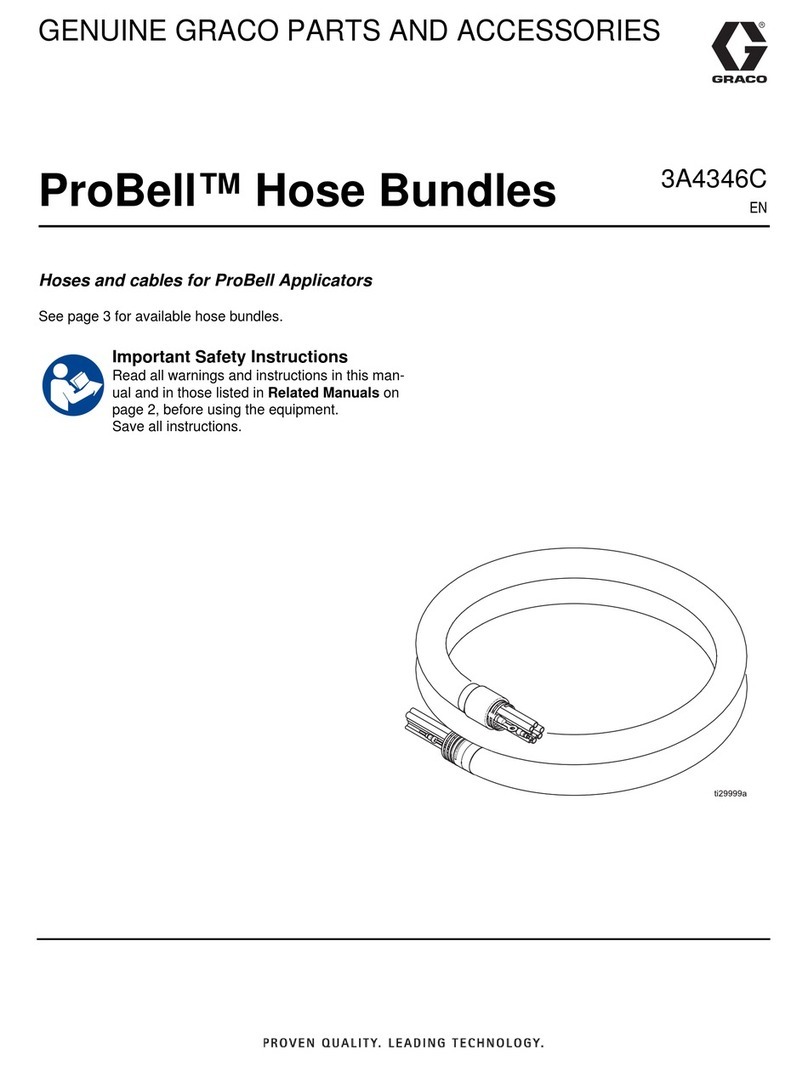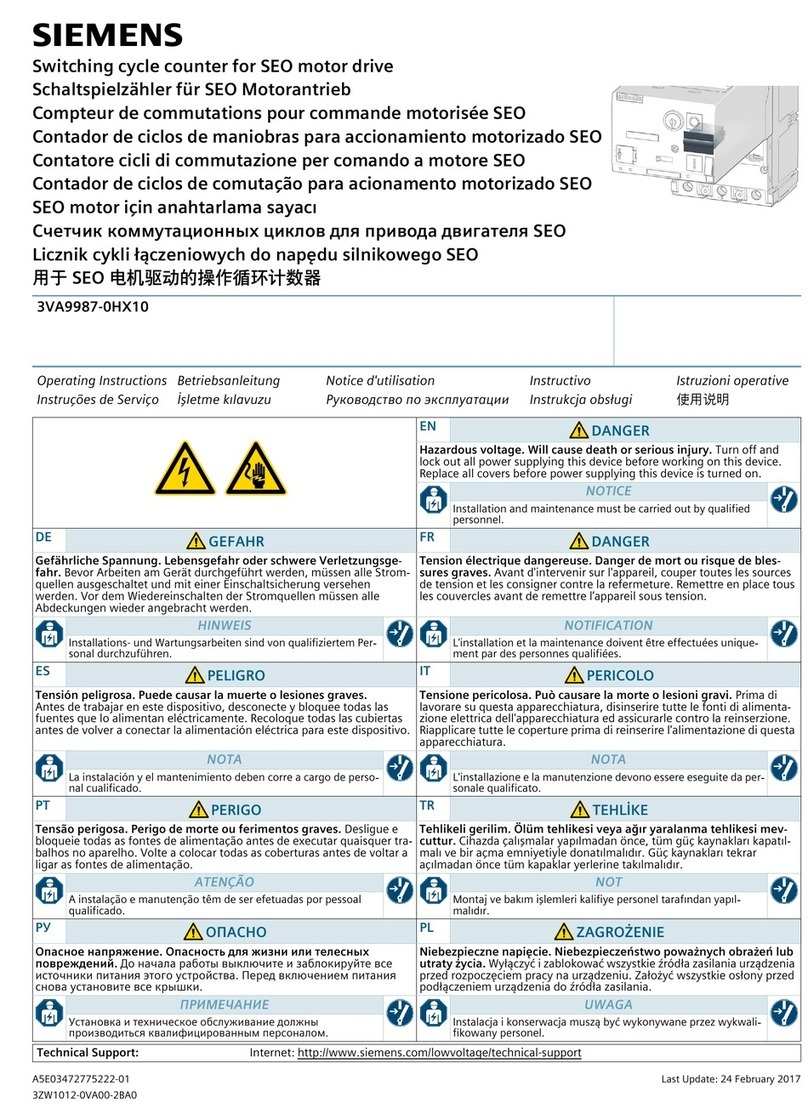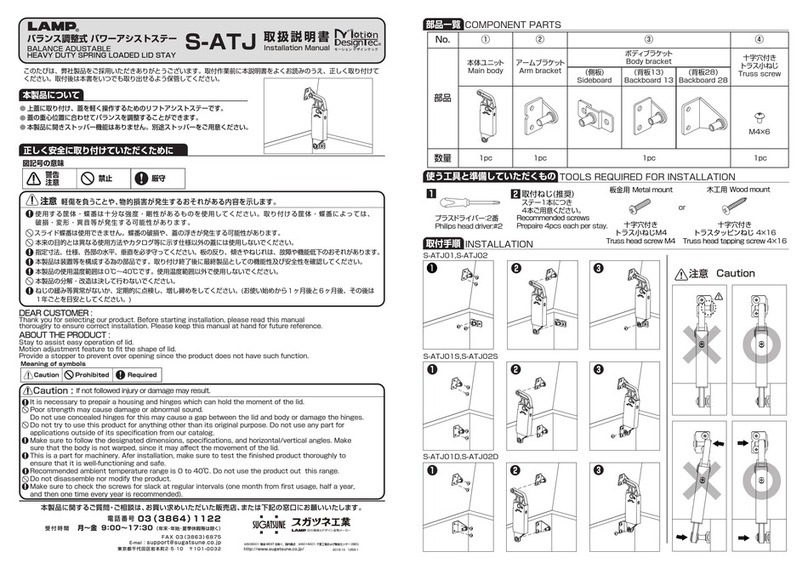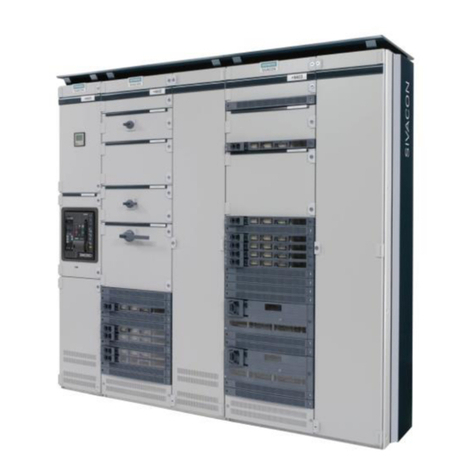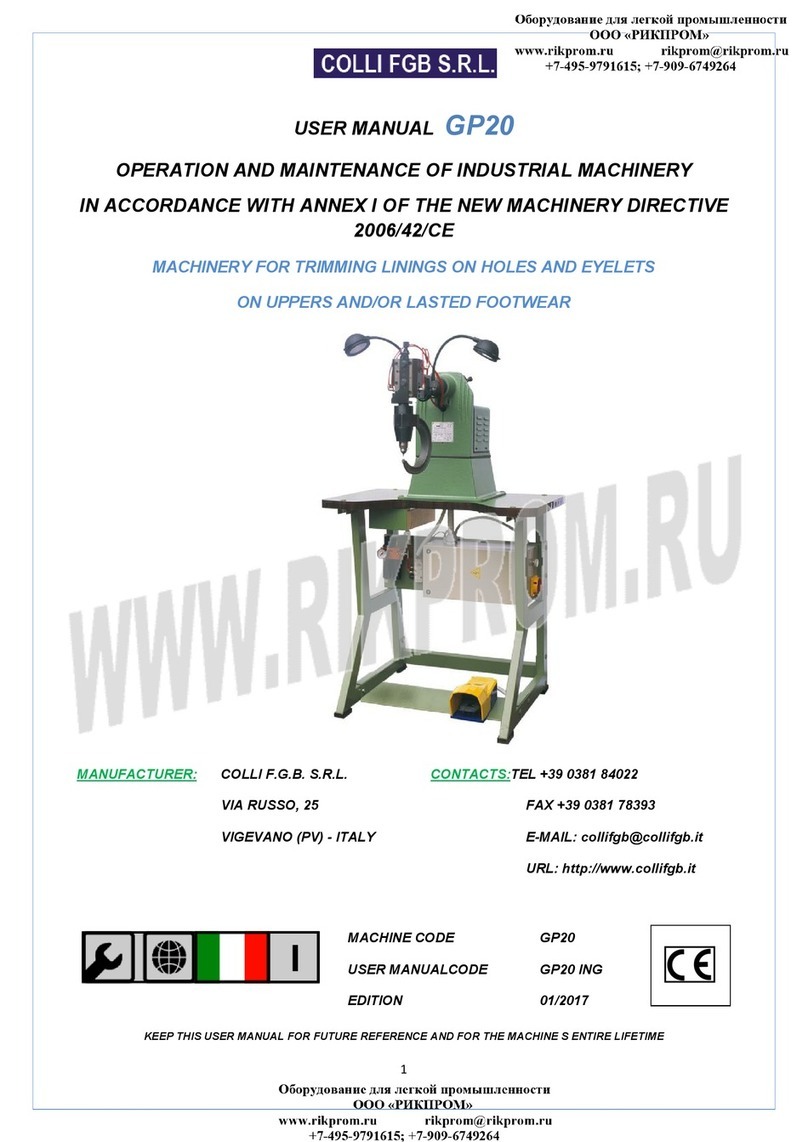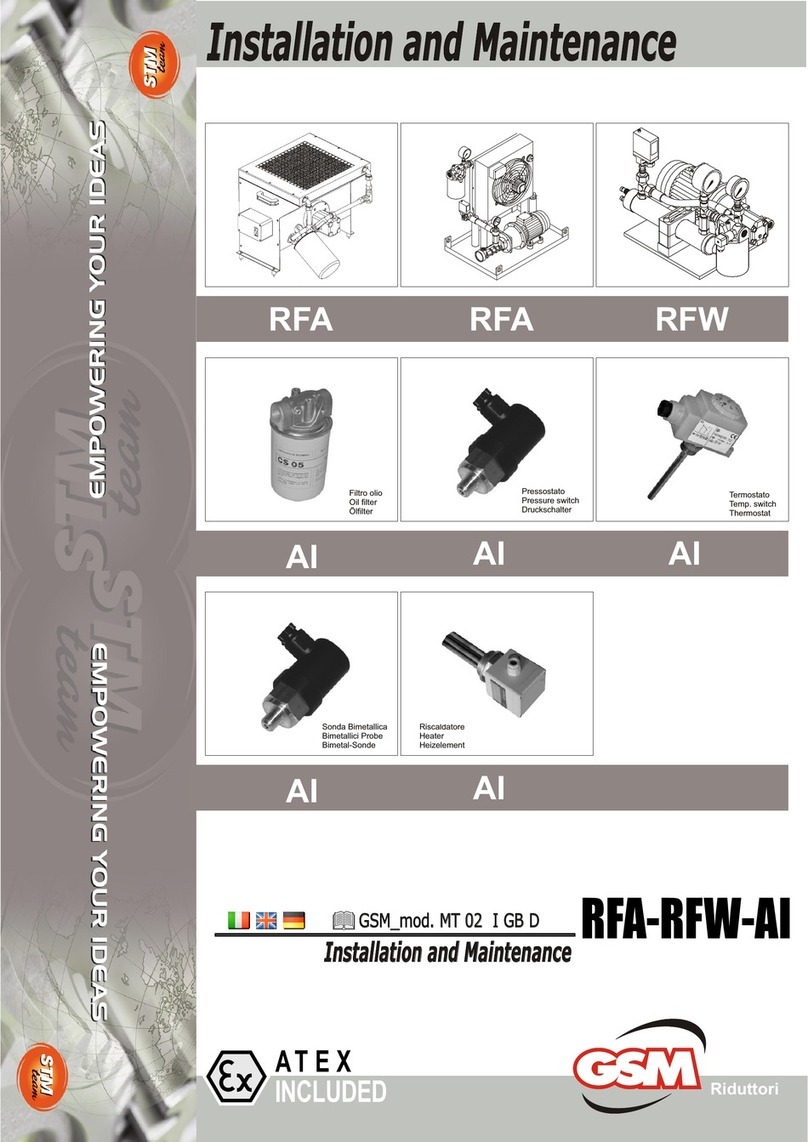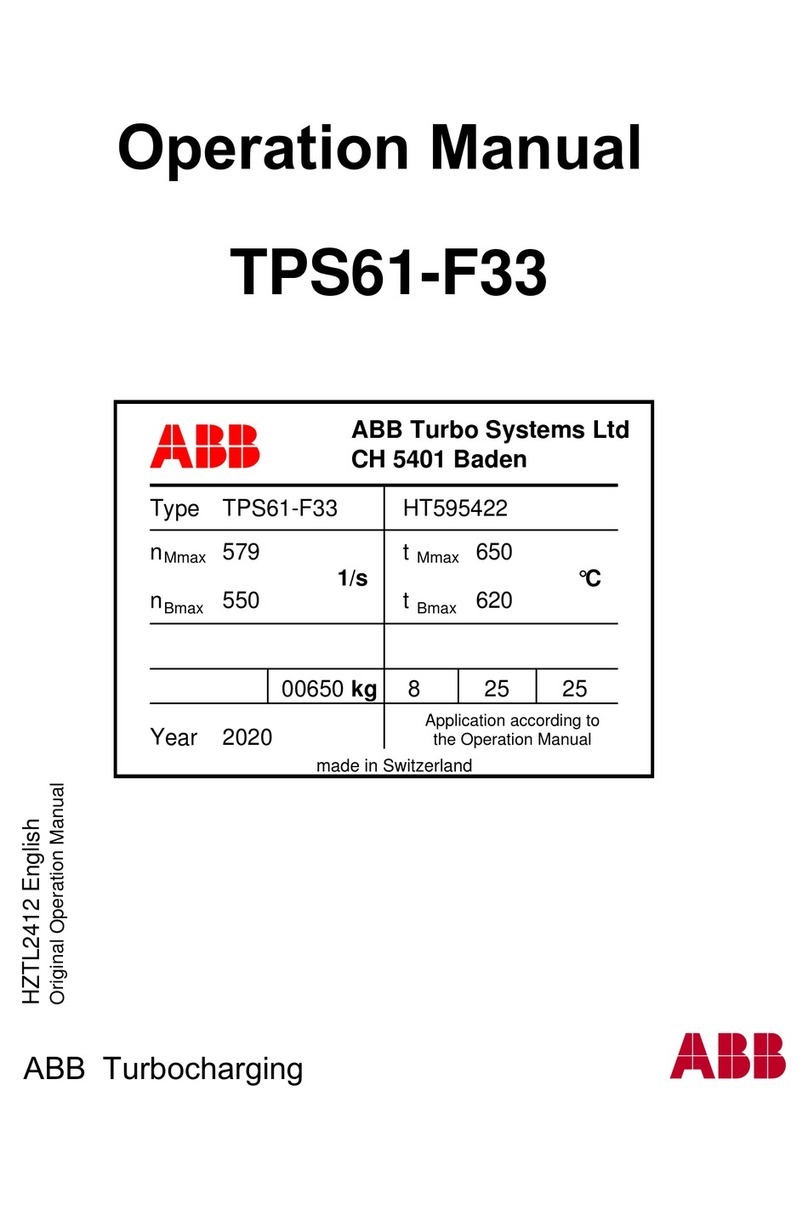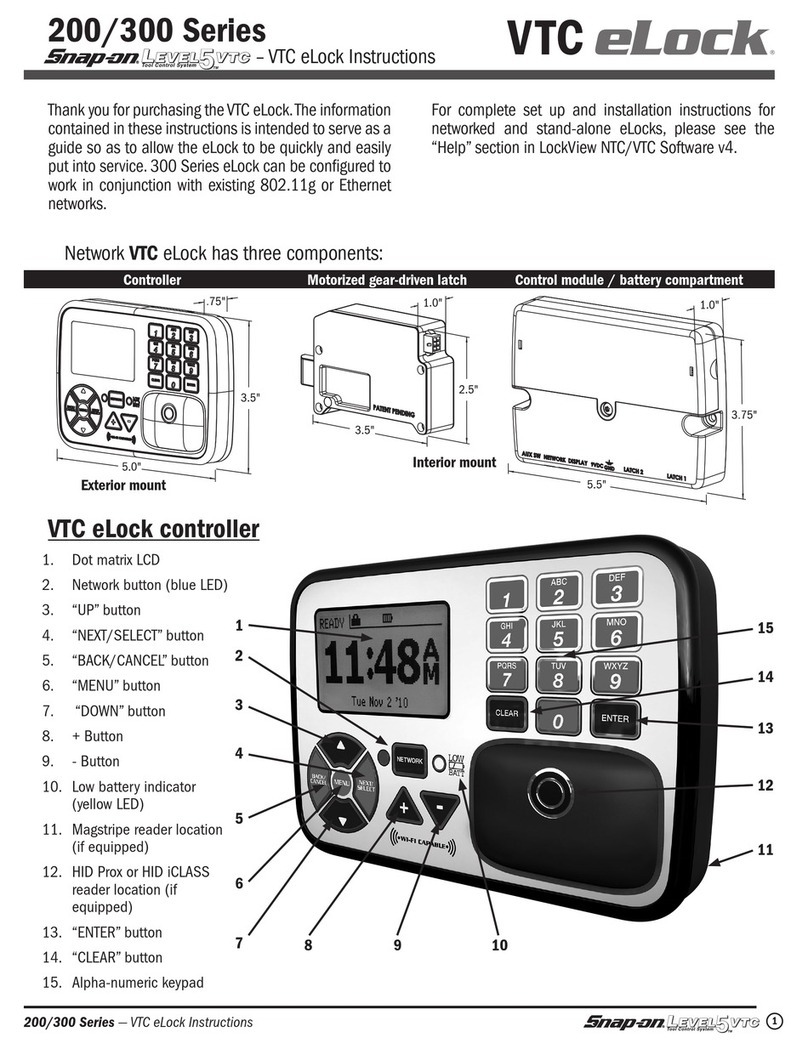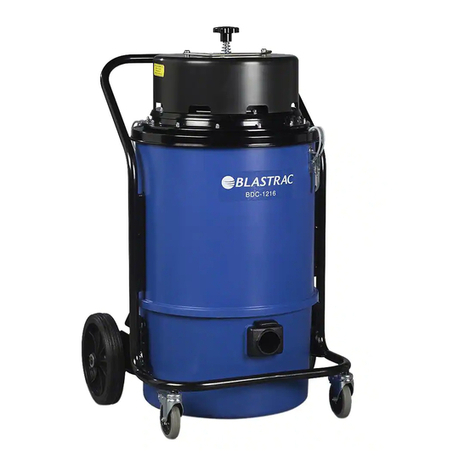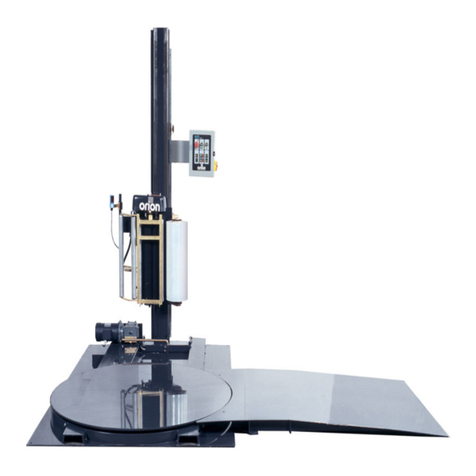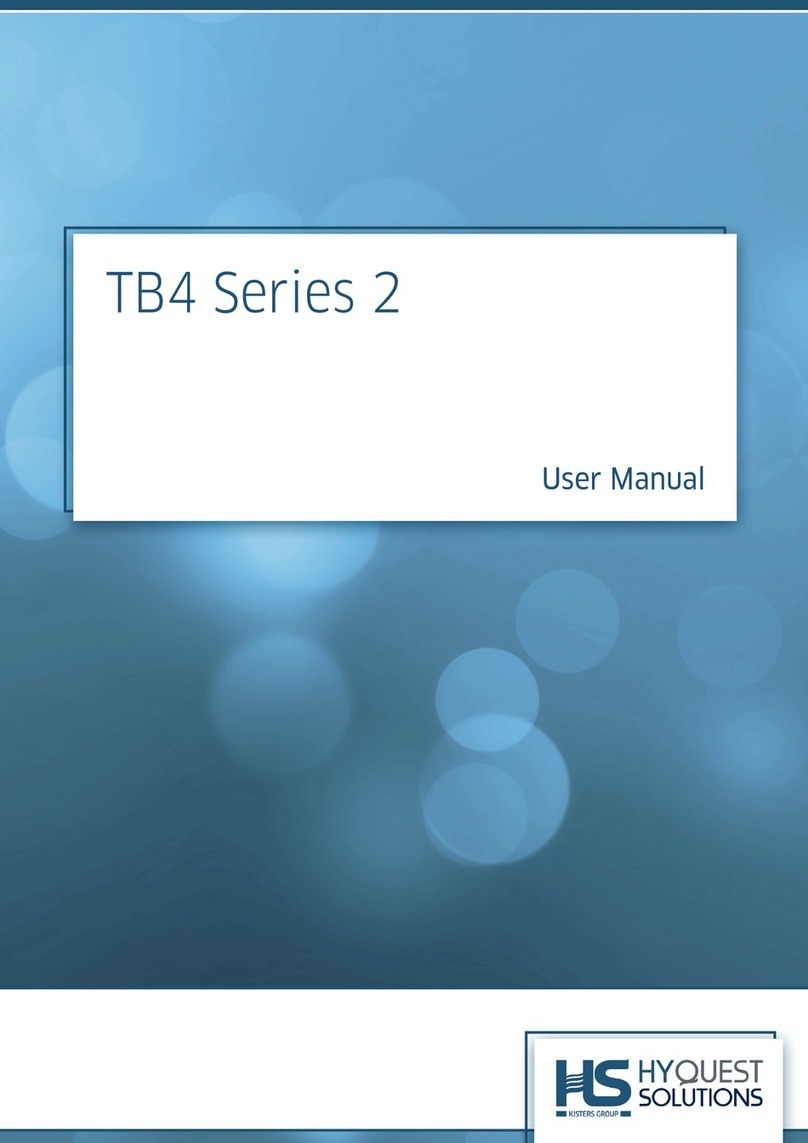Blacoh SENTRY CIP User manual

Installation and Operation Manual
CIP Sanitary Flow Through Dampener Models
SENTRY dampeners are pressure vessels containing a flexible bladder or bellows inside that separates an
inert pressurized gas (air or Nitrogen) from a system fluid in the lower chamber. Depending on how dampeners
are configured, they are used as Pulsation Dampeners, Inlet Stabilizers or Surge Suppressors to control
pressure fluctuations and spikes in liquid piping systems.
Dampeners work on the principle that volume is inversely proportional to pressure (P1V1=P2V2). Compressed
air or Nitrogen (never Oxygen) is introduced into the non-wetted side of the dampener. The gas charge is
contained by the bladder or bellows preventing contact between the system fluid and the gas.
When the dampener is sized correctly, properly installed and charged according to the instructions provided it
will greatly reduce the damaging effects of pressure variations in piping systems and significantly improve the
efficiency of transferring liquids.
All dampeners manufactured by BLACOH use pressure bodies made in the USA to insure quality. Prior
to shipment, each and every dampener is factory tested at design pressure or higher to assure proper
function and leak-free operation.
Go to www.blacoh.com for literature in multiple languages.

1 BLACOH Fluid Control
Table of Contents
SAFETY Warnings ..................................................................................................................................................................2
Safety Symbols ..........................................................................................................................................................2
General Safety...........................................................................................................................................................2
Equipment Misuse Hazard.........................................................................................................................................3
GENERAL Information............................................................................................................................................................3
Must Read Before Installation....................................................................................................................................3
Installation Notes........................................................................................................................................................4
ATEX Standard..........................................................................................................................................................4
Maintenance...............................................................................................................................................................4
Installation & Operation Instructions: CIP Sanitary Flow Through Models.......................................................................6
Charge Notes.............................................................................................................................................................6
Installation for Pump Discharge Pulsation..................................................................................................................6
Chargeable Model......................................................................................................................................................7
Adjustable Model........................................................................................................................................................8
Maintenance and Repair............................................................................................................................................8
Manufacturer’s Limited Warranty & Return Policy ............................................................................................................10
MODEL Specifications & Installation Information
DAMPENER MODEL: Chargeable Adjustable
Model No. Serial No. Installation Date
/
Body Material: Wetted / Non-wetted Bladder / Bellows Material Pump Area and Number
Purchased From Contact Phone Email
The word “dampener”, as used in this Manual, has the same meaning as Pulsation Dampener, Inlet Stabilizer or
Surge Suppressor.
Copyright © 2014 BLACOH Fluid Controls, Inc. All rights reserved.
Information in this document is subject to change without notice. No part of this publication may be reproduced, stored in a retrieval system
or transmitted in any form or by any means electronic or mechanical, including photocopying and recording for any purpose other than the
purchaser’s personal use without the express written permission of BLACOH Fluid Controls, Inc.
Temperature Limits.................................................................................................................................................... 5

BLACOH Fluid Control 2
SAFETY Warnings
Dampeners should only be installed, operated and repaired by experienced and trained professional mechanics. Read and
observe all instructions and safety warnings in this Manual before installing, operating or repairing dampeners.
Safety Symbols
The following symbols indicate cautions, warnings and notes that must be observed for safe and satisfactory installation,
operation and maintenance of dampener.
WARNINGS Danger of serious injury or death could occur if these warnings are ignored.
CAUTIONS Equipment damage, injury or death could occur if these cautions are not observed.
NOTES Special instructions for safe and satisfactory installation, operation and maintenance.
General Safety
CAUTION!
Observe all safety symbols in installation and
operation instructions.
The internal dampener pressure will equal the
maximum fluid pressure of the system in which it is
installed.
DO NOT exceed maximum allowable working
pressure (MAWP) specified on dampener serial tag
or marked on dampener. If serial tag is missing, DO
NOT use dampener without consulting distributor or
factory for maximum pressure rating.
Always make sure safety shutoff valves, regulators,
pressure relief valves, gauges, etc. are working
properly before starting system or assembly.
Verify dampener model received against purchase
order and shipper.
Before starting a system or assembly make certain
the discharge point of the piping system is clear and
safe, and all persons have been warned to stand
clear.
DO NOT put your face or body near dampener
when the system or assembly is operating or
dampener is pressurized.
DO NOT operate a dampener that is leaking,
damaged, corroded or otherwise unable to contain
internal fluid, air or gas pressure.
DO NOT pump incompatible fluids through
dampener. Consult distributor or factory if you are
not sure of the compatibility of system fluids with
dampener materials.
Dampeners are designed to operate with
compressed air or clean dry Nitrogen only. Other
compressed gases have not been tested and may
be unsafe to use. DO NOT USE OXYGEN.
Always shut off air supply, remove internal
dampener pressure and shut dampener isolation
valve before performing dampener maintenance or
repair.
Remove all pressure from dampener AND pumping
system before disassembly, removal or
maintenance.
Static spark can cause an explosion resulting in
severe injury or death. Ground dampeners and
pumping system when pumping flammable
fluids or operating in flammable environments.
NOTE: EC standard EN-13463-1 and EN-13463-5
(ATEX) require grounding (earthing) on
dampeners when the potential for static
sparking is present. A grounding point is
located and marked on ATEX specific dampener
models.

3 BLACOH Fluid Control
Equipment Misuse Hazard
CAUTION!
General Safety
DO NOT misuse dampener, including but not limited to
over-pressurization, modification of parts, using
incompatible chemicals, or operating with worn or
damaged parts. DO NOT use any gases other than
compressed air or clean dry Nitrogen to charge dampener.
DO NOT USE OXYGEN. Any misuse could result in
serious bodily injury, death, fire, explosion or property
damage.
Over-Pressurization
Never exceed the maximum pressure rating for the
dampener model being used. Maximum allowable working
pressure (MAWP) is specified on dampener serial tag or
marked on dampener. Maximum allowable working
pressure (MAWP) is rated at 70°F (21°C).
Temperature Limits
DO NOT exceed the operating temperature limits for the
body and/or elastomer materials being used. Excessive
temperature will result in dampener failure. For
temperature limits, refer to the “Temperature Limits”
section of this Manual. Temperature limits are stated at
zero psi/bar.
Installation and Start-Up Hazards
Install dampener before charging or pressurizing. DO NOT
start system or assembly without first charging or
pressurizing dampener. Failure to charge may result in
damage to the elastomeric bladder or PTFE bellows.
Temperature & Pressure Hazard
Temperature and pressure reduce the strength and
chemical resistance of plastic, metal, elastomers and
PTFE.
Charging / Pressurization
Charge or pressurize dampener with compressed air or
clean dry Nitrogen only. DO NOT USE OXYGEN.
Dampener Bladder/Bellows Failure
Dampeners utilize an elastomeric membrane (bladder) or
PTFE bellows to separate system fluid from the air supply
or gas charge. When failure occurs, system fluid may be
expelled from the air valve. Always perform preventive
maintenance and replace bladder/bellows before
excessive wear occurs. O-rings for PTFE bellows cannot
be re-used.
Maintenance Hazards
Never over-tighten fasteners. This may cause leakage of
system fluid and damage to dampener body. Bolts should
not be reused as re-torquing reduces bolt strength. After
dampener maintenance or re-assembly, use new
fasteners and torque fasteners according to
specification on dampener serial tag. If serial tag is
missing, consult distributor or factory for torque
specifications.
GENERAL Information
For safe and satisfactory operation of dampener read all safety warnings, caution statements and this complete
Manual before installation, startup, operation or maintenance.
Must Read Before Installation
DO NOT use Oxygen to charge dampener. Use
compressed air or clean dry Nitrogen only. Danger of static spark! Grounding precautions
must be considered when dampener is used in
flammable or explosive environments.
DO NOT exceed maximum allowable working
pressure (MAWP) specified on dampener serial tag
or marked on dampener.
ATEX models must be grounded (earthed) before
operation.
Turn pump off and remove all pressure from
system prior to dampener installation. DO NOT operate a dampener that is leaking,
damaged, corroded or otherwise unable to contain
internal fluid, air or gas pressure.
Always wear safety glasses and other appropriate
safety equipment when installing, charging or
repairing dampener.
Temperature, pressure and chemicals affect the
strength of plastic, elastomer and metal
components.
Many plastics lose strength rapidly as temperature
increases. Consult factory if in doubt.

BLACOH Fluid Control 4
Installation Notes
Dampening of flow pulsations can only be effective if a minimum of 5 to 10 psi (0.4 to 0.7 bar) back pressure
downstream of dampener is available. A BLACOH back pressure valve may be required downstream of
dampener, except when dampener is used as an inlet stabilizer for the inlet side of the pump.
It is recommended that a BLACOH pressure relief valve be installed in all pump systems to ensure compliance
with pressure limits on system equipment.
To avoid possible damage to bladder/bellows from a system pressure test:
Adjustable and Chargeable models — charge dampener to 80% of the system test pressure prior to test.
Automatic model — prior to test, dampener must be equipped with a constant source of compressed air with
pressure equal to or greater than system test pressure.
Inlet Stabilizer model — maximum pressure test 30 psi (2.0 bar), charge to 20 psi (1.3 bar) for system pressure
test.
Install dampener in-line as close to the pump discharge/inlet or quick closing valve as possible. Dampener
installation should be no more than ten pipe diameters from pump discharge/inlet or quick closing valve.
It is recommended that an isolation valve be installed between the dampener and system piping.
ATEX Standard
Certain models made for the European market comply with the ATEX standard for use in potentially explosive
atmospheres. These models have the AT designation at the end of the part number and comply with EC standard
EN-13463-5 with protection degree of II 2GD TXC. AT models have a grounding lug and must be grounded
(earthed) before operation.
Maintenance
Remove all pressure from dampener AND pumping system before disassembly, removal or maintenance.
Dampeners require very little maintenance. There is only ONE wear part – the elastomeric bladder or the PTFE bellows.
There is no need for lubrication.
Elastomeric bladder replacement should be part of a preventive maintenance program. Dampeners used in conjunction with
diaphragm pumps should have the bladders replaced at least every second time the diaphragms in the pump are replaced.
As with any pumping system, wear is dependent on many factors including material, temperature, chemicals, fluid
abrasiveness and system design. This suggested maintenance program may need to be adjusted according to specific
applications.
Periodic inspection of the dampener and fasteners should be conducted to visually check for signs of over-pressurization,
fatigue, stress or corrosion. Body housings and fasteners must be replaced at first indication of deterioration.
CAUTION! Replace nut and bolt fasteners at each re-assembly with fasteners of equal grade/strength
value. DO NOT re-use old nuts and bolts.
After the initial torque of fasteners, bolts may lose strength when re-torqued. Failure to replace both nuts and bolts upon
each vessel reassembly will void the product warranty given by the manufacturer and the manufacturer will have no liability
whatsoever for any vessel failure or malfunction.
Where dampeners are used in corrosive environments, nut and bolt fasteners should be regularly inspected and replaced
with nut and bolt fasteners of equal grade/strength value if corrosion is observed. Failure to conduct such regular inspections
and replacement will void the product warranty given by the manufacturer and the manufacturer will have no liability
whatsoever for any vessel failure or malfunction.
IMPORTANT! After maintenance or re-assembly, use new fasteners and torque fasteners according to
specification on dampener serial tag. If tag is missing, consult distributor or factory for specifications.
DO NOT use dampener if the fasteners (nuts and bolts) are corroded. Check for fastener corrosion frequently,
especially in atmospheres containing salt or corrosive chemicals, or if dampener leakage has occurred.

5 BLACOH Fluid Control
Temperature Limits
Operating temperatures are based on the maximum temperature of the wetted dampener components
only. Non-wetted dampener components may have a lower temperature limit. Temperature and certain
chemicals may reduce the maximum allowable working pressure (MAWP) of the dampener.
CAUTION! Plastic (non-metallic) body materials lose strength as temperature increases, which reduces
the maximum pressure sustainable by the material. All plastic materials must have an appropriate de-
rating factor applied when working at elevated temperatures above 73.4°F (23°C) to determine maximum
allowable working pressure (MAWP).
Elastomer
Materials Temperature Limits Applications
Aflas 0°F to +400°F (-18°C to +204°C) High temperature, petroleum based chemicals, strong acids and
bases.
Buna-N +10°F to +180°F (-12°C to +82°C) Good flex life; use with petroleum, solvents and oil-based fluids.
FDA Buna-N +10°F to +180°F (-12°C to +82°C) FDA-approved food grade; similar characteristics of regular Buna-N.
EPDM -60°F to +280°F (-51°C to +138°C) Use in extreme cold; good chemical resistance with ketones,
caustics.
FDA EPDM -50°F to +225°F (-45°C to +107°C) FDA-approved food grade; similar characteristics of regular EPDM.
Hypalon -20°F to +275°F (-29°C to +135°C) Excellent abrasion resistance; good in aggressive acid applications.
Neoprene 0°F to +200°F (-18°C to +93°C) Good abrasion resistance and flex; use with moderate chemicals.
PTFE Diaphragm +40°F to +220°F (+4°C to +104°C) Use with highly aggressive fluids.
PTFE Bellows -20°F to +220°F (-29°C to +104°C) Exclusive bellows design with excellent flex life; use with highly
aggressive fluids.
Santoprene -20°F to +225°F (-29°C to +107°C) Excellent choice as a low cost alternative for PTFE in many
applications.
FDA Silicone -20°F to +300°F (-29°C to +149°C) FDA-approved food grade material; for use in food and
pharmaceutical processing.
USP Class VI
Silicone -20°F to +300°F (-29°C to +149°C) Pharmaceutical grade material; for use in food and pharmaceutical
processing.
Viton®-10°F to +350°F (-23°C to +177°C) Use in hot and aggressive fluids; good with aromatics, solvents,
acids and oils.
Non-Metallic
Body Materials Temperature Limits Applications
Acetal* +32°F to +175°F (0°C to +79°C) Good flex life; low moisture sensitivity; high resistance to solvents
and chemicals.
CPVC +32°F to +180°F (0°C to +82°C) Chlorinated PVC (CPVC): Good general chemical resistance; loses
strength as temperature rises.
Noryl +32°F to +220°F (0°C to +104°C) Good resistance to acids and bases; good temperature stability.
Polypropylene* +32°F to +175°F (0°C to +79°C) Good general purpose plastic; broad chemical compatibility at
medium temperatures.
PTFE +40°F to +220°F (+4°C to +104°C) Use with highly aggressive fluids, high temperatures.
PVC +32°F to +140°F (0°C to +60°C) Good general chemical resistance; loses strength as temperature
rises.
PVDF +10°F to +200°F (-12°C to +93°C) Excellent resistance to most acids and bases; high temperatures.
* Conductive Acetal and Conductive Polypropylene available.
[T22E11_010]

BLACOH Fluid Control 6
Installation & Operation Instructions: CIP Sanitary Flow Through Models
ATEX models must be grounded (earthed) before operation.
Turn pump off and remove all pressure from system prior to dampener installation.
Remove all pressure from dampener AND pumping system before disassembly, removal or maintenance.
Use compressed air or clean dry Nitrogen to charge dampener. DO NOT USE OXYGEN.
DO NOT exceed 150 psi (10.3 bar) maximum allowable working pressure (MAWP). Check maximum pressure rating
specified on dampener serial tag. If tag is missing, consult distributor or factory for specifications.
Always wear safety glasses and other appropriate safety equipment when installing, charging or repairing dampener.
Read and observe all safety warnings and instructions in this Manual before installation, operation or repair.
Before performing a system pressure test, dampener must be charged with 30% of system test pressure to avoid
possible damage to bladder.
Dampener must be cleaned and/or sanitized before use in a sanitary system.
Charge Notes Read Before Installation
To be effective, dampener must be properly charged with compressed air or clean dry Nitrogen. DO NOT USE
OXYGEN. The gas used to charge the dampener may be required to meet standards established by 3A, EHEDG
and/or other agencies. The dampener cannot be charged until properly installed in the system.
The CIP dampener is available with two types of air controls for gas charging.
Adjustable Model
The adjustable model uses a self-relieving regulator and pressure gauge to set and control the gas charge in the
dampener. This model provides a means to easily adjust pressure to maximize dampener response but, a
compressed air line must be permanently attached to the dampener.
Chargeable Model
The chargeable model uses a Schrader type fill valve and pressure gauge to pre-charge the dampener. This type of
control is generally used when no source of compressed air is available near the dampener.
IMPORTANT! Do not charge dampener to more than 30% of pump discharge pressure. Overcharging
dampener may result in bladder failure. If dampener is overcharged compared to pump discharge
pressure, bladder will close and pump flow will be reduced or stopped. Symptoms of overcharging
include reduced flow, dampener vibration and/or pump shutdown.
Installation for Pump Discharge Pulsation Read Before Installation
Installation Position
The CIP dampener is a flow-through design with 2 ½” tri-clamp connections on each end and should be installed in-line, as
close to the pump discharge as possible to absorb the pulse at its source and before any downstream equipment such as risers,
valves, elbows, meters, or filters. Dampener installation should be no more than ten pipe diameters from pump discharge. For
mechanical cleanability (clean-in-place or CIP), dampener can be installed in a downward angled position to assure complete
drainage. Vertical or horizontal installation is acceptable for in-line application (see FIGURE 1).
IMPORTANT! Dampener must be installed in the system with the arrow on the dampener body
pointing away from the pump and in the direction of fluid flow.
IMPORTANT! The tri-clamp style clamps used to install the dampener in the system must be installed
correctly and tightened completely, the clamps create product seal AND provide compressed gas
sealing so the dampener will hold the pressure charge.

7 BLACOH Fluid Control
Dampener can be installed vertically on a tee in the system piping. Vertical installation requires a cap be installed on the top
end of dampener. This type of installation, referred to as appendage installation, will cause product holdup and cannot be
used for mechanical (CIP) applications. If a flexible connector is used in the piping system, attach dampener to the pump’s
discharge outlet and connect the flexible connector to the downstream end of dampener.
FIGURE 1
Chargeable Model Read Before Installation
Charging and Start-Up (see Charge Notes)
Chargeable models do not require an air line connection. Dampener should be pre-charged with 3A standard approved
compressed air or clean dry Nitrogen. Use a hand pump, Nitrogen tank or air compressor to charge dampener. DO NOT
USE OXYGEN. Charging hose kits are available from BLACOH.
Prior to starting the pump, pre-charge the dampener to approximately 30% of expected system pressure and replace fill
valve cap. DO NOT USE OXYGEN. The pre-charge pressure in the dampener must always be lower than pump discharge
pressure. Start the pump to generate system pressure. The dampener charge pressure may need to be adjusted up or down
to be most effective in reducing pulsation. NOTE: The most effective method to set the proper dampener charge is to install
a glycerin-filled pressure gauge downstream of the dampener and adjust the dampener to minimize needle movement on the
gauge.
Once system pressure is in contact with the bladder, the gas charge will be compressed to the system pressure and
the dampener gauge will read the system pressure, not the initial charge pressure. Once working pressure is
achieved, adjustment may be necessary. Gradually increase or decrease the gas charge in the dampener by bleeding or
filling through the gas valve. Allow the system to respond to each adjustment (this may take a minute or two) before making
further adjustments. NOTE: It is important to replace the charge valve cap tightly after charging because pressure can be
slowly lost through a valve without a cap.
FLEX
CONNECTOR
COMPOUND
PRESSURE GAUGE
AIR SUPPLY
PUMP FLEX
CONNECTOR
PRESSURE GAUGE/
INSTRUMENTATION
DISCHARGE
INLET
FRL OPTIONAL VERTICAL
APPENDAGE
CAP
30"
25"
20"
30"
10"
0
20"
15"
5"
10"
Psi
BLACOH
(SCALE: 1: 1 1/2) SK1005, REV D
CIP DAMPENER

BLACOH Fluid Control 8
Adjustable Model Read Before Installation
Step 1 – Air Line Connection
Using a 1/4” flexible air hose (I.D. of the hose must be 1/4” or 6.4 mm minimum) run an air line from a compressed gas
source to the one-way check valve on the dampener’s regulator.
DO NOT remove one-way check valve. The check valve prevents fluid back flow through the air hose in case of bladder
failure. The air supply pressure to the dampener must be greater than the pump discharge and/or system pressure. If the
dampener is being used in conjunction with a pneumatically operated pump, a tee can be used to run the air line to the
dampener from the existing pump air supply line (see FIGURE 1). The tee should be placed before any in-line pump
instrumentation such as a filter, regulator, lubricator or other pump control valve.
Step 2 – Charging and Startup
Prior to starting the pump, adjust the regulator on dampener to approximately 30% of expected system pressure at the
pump’s discharge outlet. For example, if the liquid pressure at the pump discharge is 60 psi (4.1 bar), initial dampener
charge should be 20 psi (1.3 bar).
Note: Dampener must be charged before the pump is started. If dampener pressure charge is set too high, then the bladder
will be squeezed and flow will be restricted. The most effective way to set the proper dampener charge is to install a glycerin-
filled pressure gauge downstream of the dampener and adjust the dampener to minimize needle movement on the gauge.
After the pump is started minor pressure adjustments to the dampener may be required to maximize dampener performance.
Since the dampener regulator is the self-relieving type, it is easy to raise or lower the dampener pressure to obtain best
dampening results.
Once system pressure is in contact with the bladder, the air charge will be compressed to the system pressure and
the dampener gauge will read approximately 1/3 to 1/2 of system pressure, not the initial charge pressure. Once
working pressure is achieved, adjustment may be necessary. Gradually increase or decrease the air charge in the dampener
by bleeding or filling through the self-relieving pressure regulator. Allow the system to respond to each adjustment (this may
take a minute or two) before making further adjustments.
Maintenance and Repair Read Before Installation
The only maintenance required is the periodic checking of the gas pressure charge on the Chargeable model.
Normally, if dampener is properly installed, pre-charge pressure should be checked every two to three months or
when dampener effectiveness is reduced, which indicates a loss of charge. Refer to charging instructions above.
Bladder Replacement
IMPORTANT! Bladder must be installed in one direction only or bladder damage will occur. The side of the
bladder has an arrow molded in it indicating the direction of fluid flow inside the dampener. The arrow on the
bladder must point in the same direction as the arrow on the dampener body. Dampener must be installed in
the system with the arrow on the dampener body pointing away from the pump in the direction of fluid flow.
1. Before replacing the bladder, dampener must be removed from the pipe system.
2. To remove the bladder, fold the bladder lip seal down into the center of the bladder while pulling the bladder
out from the opposite end of dampener body.
3. To install a new bladder, insert the bladder into one end of dampener body as far as it will go. Reach into the
opposite end, fold the lip seal edges toward the bladder center and pull the bladder end out of the body.
Pushing the bladder from the opposite end while pulling will assist in bladder installation. A sanitary/food grade
oil can be applied to the lip seal to help with installation.
4. If dampener is used in a sanitary application, dampener body must be cleaned and sanitized internally before
reuse after repair.

9 BLACOH Fluid Control
NOTES

BLACOH Fluid Control 10
Manufacturer’s Limited Warranty & Return Policy
Standard Product Limited Warranty
Subject to the limitations set forth below, BLACOH Fluid Controls, Inc. ("BLACOH") warrants its products to be free from
defects in material and workmanship under normal use, service, and maintenance in accord with BLACOH’s published
specifications for a period of two years from date of shipment by BLACOH (the "Warranty"). The EXCLUSIVE REMEDY for
any product defect covered under this Warranty shall be one of the following, as determined by BLACOH in BLACOH’s sole
discretion: (a) refund of the purchase price; or (b) replacement or repair of the defective part or parts at BLACOH’s facility.
This Warranty will be null and void if the product is used in an inappropriate application or if the product has been altered,
misapplied, improperly installed, or not properly inspected and maintained. To the maximum extent allowed by applicable
law, BLACOH will not be responsible for nor have any liability for any “Damage,” which means any of the following, whether
the claim sounds in breach of contract, breach of warranty, tort, strict liability, implied contractual indemnity, or otherwise: (i)
any damage, loss, or injury of any kind, or destruction, or death, whether or not caused by any defect in a BLACOH product
and whether or not the BLACOH product is installed, used, operated, and/or maintained in accord with BLACOH instructions,
to other products, machinery, buildings, property, or persons, and (ii) any costs, expenses, losses, or incidental,
consequential, or special damages of any kind or nature, including but not limited to loss of profits, arising from or related to
any BLACOH product, whether or not caused by any defect in a BLACOH product and whether or not the BLACOH product
is installed, used, operated, and/or maintained in accord with BLACOH instructions. Damage resulting from chemical
incompatibility or from over-pressurization of a product, whether from gas or fluid, is not covered under this Warranty, nor will
BLACOH be responsible in any way for any such Damage. Because BLACOH does not determine and cannot anticipate or
control the many different conditions under which its products may be used, BLACOH does not warranty the applicability,
suitability, or fitness of any of its products for any particular use or purpose. Statements concerning the possible use of
BLACOH products are not intended and shall not be interpreted as warranties of fitness for any specific use of such
products. Each user of BLACOH products must conduct its own engineering analysis and tests to determine the suitability of
each BLACOH product for the user's intended uses or purposes, including but not limited to chemical compatibility and
pressurization, and any written or oral assistance from BLACOH in this regard does not relieve the user from exclusive
responsibility for such engineering analysis and testing. BLACOH products are sold with only this limited Warranty, and each
buyer assumes all responsibility for Damage (as defined above), including but not limited to, Damage arising from defects in
BLACOH products and/or from the handling and use of BLACOH products whether used in accordance with BLACOH's
directions or otherwise. Any products sold by BLACOH which are manufactured by and sold under the name of another
company are NOT WARRANTED by BLACOH under the foregoing Warranty or otherwise. The buyer must rely exclusively
on the product warranty, if any, given by such other company. Products manufactured by BLACOH as an original equipment
manufacturer (OEM) to be sold by a customer under the customer’s brand and name are warranted by BLACOH only under
the above Warranty, and BLACOH shall have no liability whatsoever with respect to any representation or warranty given by
such customer (or such customer’s representatives, distributors, agents, employees, or independent contractors) to any of its
buyers which is different in any respect whatsoever from the foregoing Warranty. EXCEPT FOR THE WARRANTY GIVEN
ABOVE, WHICH IS SUBJECT TO THE ADDITIONAL LIMITATIONS STATED ABOVE, AND EXCEPT FOR THE
ADDITIONAL LIMITED WARRANTY ON BLACOH’S PTFE BELLOWS STATED BELOW, BLACOH GIVES NO WARRANTY
OF ANY NATURE WHATSOEVER, EXPRESS OR IMPLIED, WITH RESPECT TO ANY OF ITS PRODUCTS, INCLUDING
WITHOUT LIMITATION NO WARRANTY OF MERCHANTABILITY AND NO WARRANTY OF FITNESS FOR A
PARTICULAR PURPOSE. NO COURSE OF DEALING, USAGE OF TRADE, OR OTHER ORAL OR WRITTEN
STATEMENTS SHALL MODIFY THE FOREGOING WARRANTY PROVISIONS AND LIMITATIONS IN ANY RESPECT
WHATSOEVER. This Warranty shall be governed by and construed in accordance with the laws of the State of California.
PTFE Bellows Limited Warranty
In addition to BLACOH's Standard Product Limited Warranty and subject to the limitations set forth below, BLACOH warrants
that its PTFE Bellows equipment (“PTFE Bellows”) on BLACOH's PTFE Bellows-fitted pulsation dampener will perform in
accordance with BLACOH's written product description for three years from date of shipment ("PTFE Bellows Warranty").
This PTFE Bellows Warranty applies only to PTFE Bellows that are sized, charged, installed, used, operated, and
maintained strictly in accordance with all installation, use, operation, and maintenance instructions provided by BLACOH,
and failure to properly size, charge, install, use, operate, and maintain the PTFE Bellows (or failure to do any of them) shall
make the PTFE Bellows Warranty null and void. This PTFE Bellows Warranty does not include applications where failure of
performance is due to an unbalanced pressure load or a transient pressure spike (sometimes called a water hammer). The
EXCLUSIVE REMEDY for breach of this PTFE Bellows Warranty is replacement of the PTFE Bellows at BLACOH’s facility,
and not any other equipment or parts whatsoever, and BLACOH will not be responsible for any Damage or any other loss of
any kind, including but not limited to incidental, consequential, or special damages (including but not limited to loss of
profits), in any way arising from failure of the PTFE Bellows to perform in accordance with BLACOH’s written product
description. This PTFE Bellows Warranty shall be governed and construed in accordance with the laws of the State of
California.

M21E11_082
Warranty Claims
5. Prior to returning any product to BLACOH based on a claim of breach of Warranty or PTFE Bellows Warranty, a
BLACOH Return Request form must be completed. The form will be reviewed by BLACOH to determine if a Return
Merchandise Authorization (RMA) number will be issued. The issuance of an RMA number does not constitute
BLACOH's acknowledgment or agreement that the warranty claim is justified or correct.
6. If an RMA number is issued by BLACOH, customer should then deliver the product in question to the address specified
on the RMA, freight prepaid.
7. All products so returned to BLACOH based on a claim of breach of Warranty or of PTFE Bellows Warranty must be
cleaned, sanitized and neutralized prior to shipment to BLACOH. BLACOH will not accept any part that contains
corrosive chemicals, organic cultures, blood, any harmful residue or air borne materials that might contaminate a
breathable atmosphere or put at risk any person or property. Any shipment that does not comply will be returned at the
expense of the customer, or the customer will be required to arrange for pickup.
8. HAZMAT SHIPMENTS WILL BE REMOVED AND PROCESSED AT CUSTOMER'S EXPENSE.
9. Receipt by BLACOH of a return does not constitute BLACOH's agreement that BLACOH is in breach of its Warranty or
PTFE Bellows Warranty.
10. If BLACOH determines that a defect in workmanship or material of a part has occurred, customer is not entitled to a
complete unit replacement. In the event of such a defect, BLACOH will repair or replace the defective part or parts or
refund the purchase price, as BLACOH determines in BLACOH’s sole discretion.
New Product Returns
1. If a customer wishes to return a new, unused product, the customer must first request a Return Merchandise
Authorization (RMA) number from BLACOH. BLACOH will determine if the unit can be returned for possible credit.
2. Product to be returned must be new, unused, and of current design and purchased within thirty (30) days of the return
request. In addition the product must not have been damaged after original shipment by BLACOH.
3. Product returns must be delivered, freight prepaid.
4. BLACOH has the right to inspect all returned products prior to acceptance or rejection.
5. ALL RETURNS are subject to a minimum $50.00 or 30% restocking fee, whichever is greater. (Higher restocking fees
may be charged on special items and some models may not be eligible for return). Returns accepted by BLACOH will be
credited to the customer's account less the re-stocking fee. Refunds will not be issued.
6. Any outsourced product supplied by BLACOH will be subject to the warranty, return policy and re-stock fee charged by
the manufacturer of the outsourced product.
[L11E11_060]
BLACOH Fluid Control
601 Columbia Ave, Bldg D
Riverside, CA 92507 USA
Phone:951.342.3100
800.603.7867
Fax: 951.342.3101
www.BLACOH.com
Table of contents
Other Blacoh Industrial Equipment manuals
Popular Industrial Equipment manuals by other brands
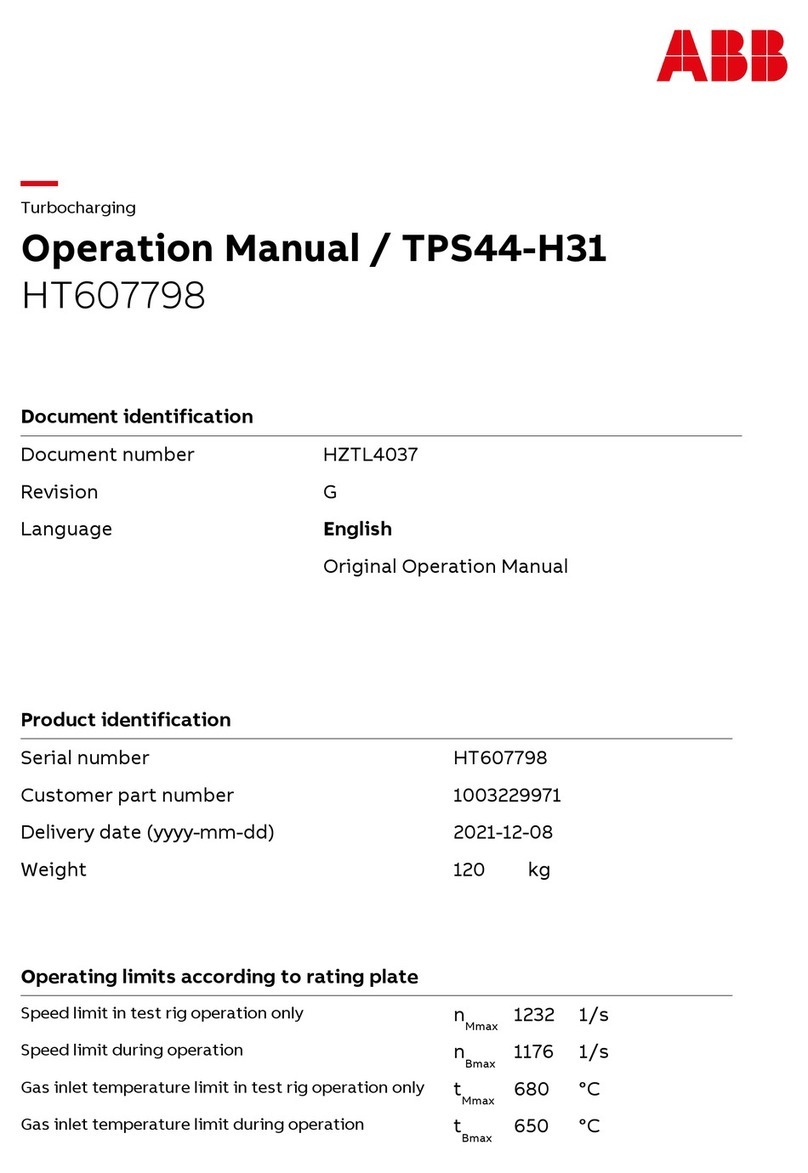
ABB
ABB HT607798 Operation manual

Fröling
Fröling GAR 110 Installation and operating instructions
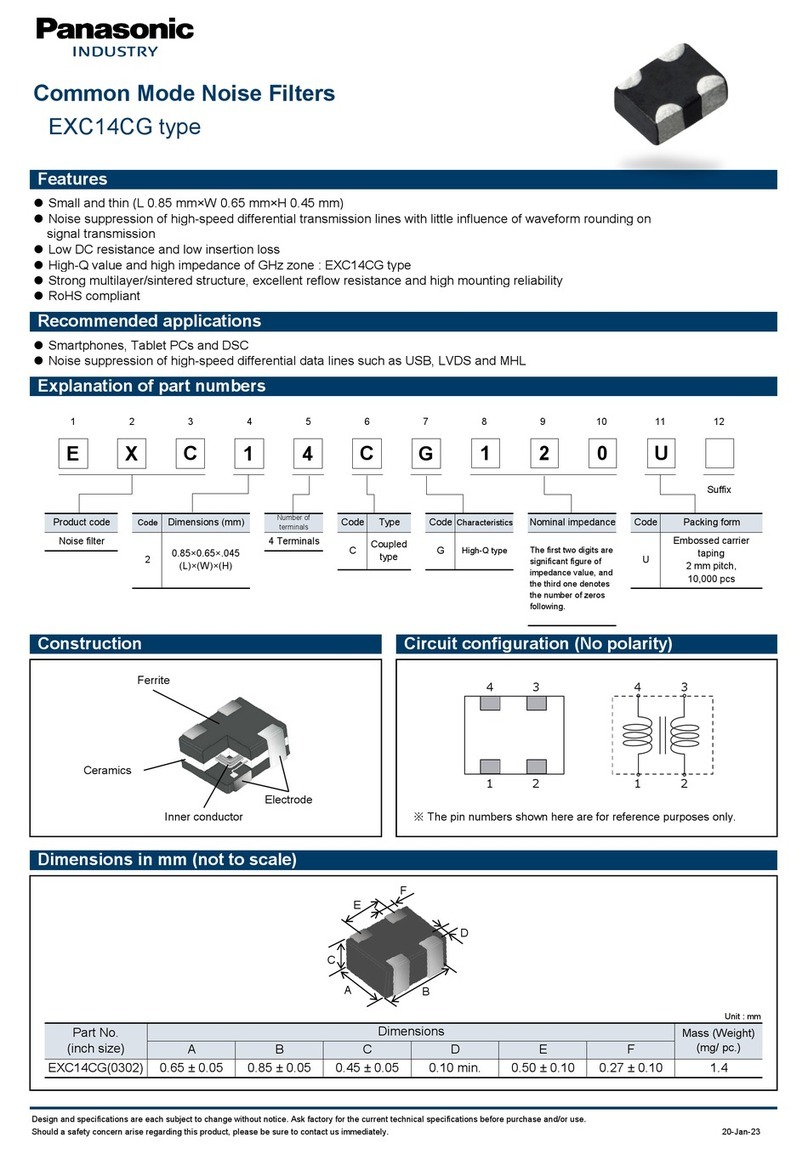
Panasonic
Panasonic EXC14CG quick start guide
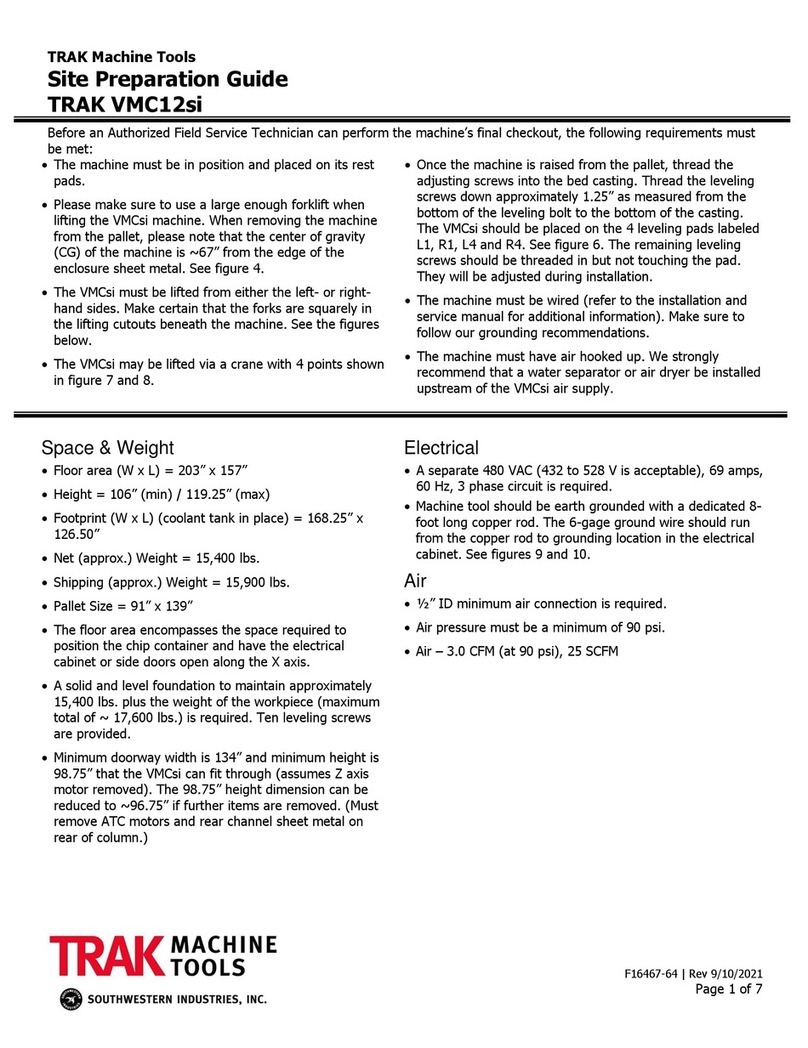
TRAK
TRAK VMC12si Site preparation guide
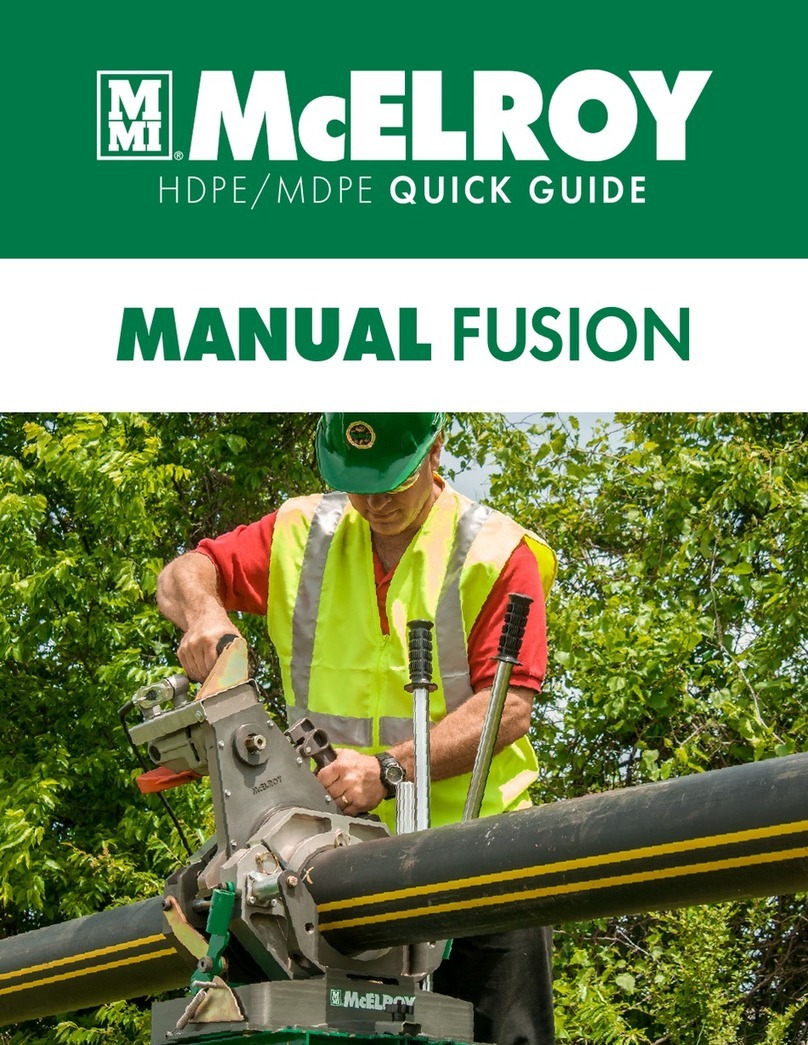
McElroy
McElroy HDPE quick guide
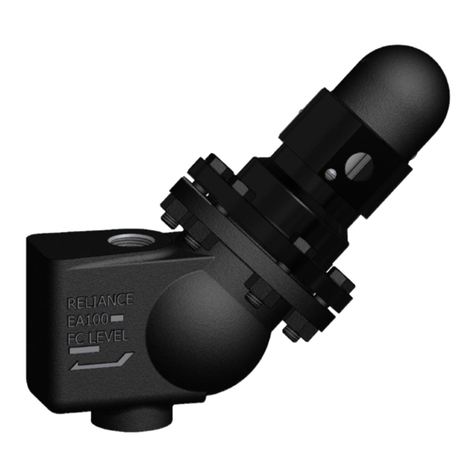
Clark-Reliance
Clark-Reliance Levalarm EA100 Series Instructions for installing and operating
